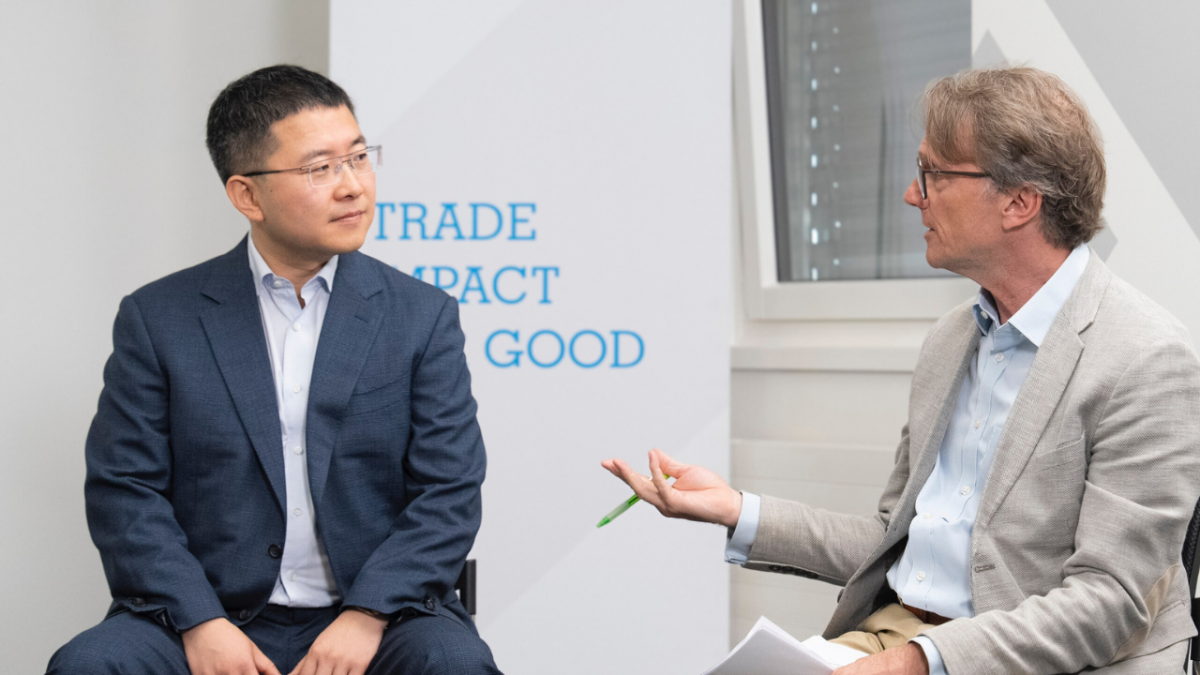


Kuo Zhang, President of Alibaba.com, delivers a keynote speech called "The B-Side Story of E-Commerce" at the Web Summit. Photo credit: Alibaba Group
Wholesale marketplace Alibaba.com has spotted an opportunity to grow in Europe as the migration of small businesses online accelerates across the region.
Advances in artificial intelligence and the proliferation of digital tools are combining to ease cross-border trade, Alibaba.com’s President Zhang Kuo told Alizila in a recent interview.
As one of the world’s largest business-to-business marketplaces, hosting over 40 million buyers, 200,000 suppliers and 200 million products at last count, Alibaba.com is well-positioned to help merchants benefit from the shift.
Its ranks of buyers recorded healthy growth this year, while Alibaba.com’s gross merchandise value (GMV) increased significantly in the last seven years, said Zhang.
At the time of its launch in 1999, small and medium-sized businesses (SMBs) accounted for less than 1% of China’s exports. By 2020, this topped 68%, according to intergovernmental economic organization OECD.
In Europe, small businesses contribute around 30%.
“So, we see a growth opportunity,” said Zhang, an alumnus of Taobao, Microsoft and IBM who has been at Alibaba.com for six years.
Alibaba.com, part of the Alibaba International Digital Commerce Group, announced an investment this week in Hamburg-headquartered B2B company Visable to accelerate expansion in Europe.
The platform will support the growth of Visable’s B2B sites wlw (known as Wer liefert Was) and europages in Europe, which serve many smaller enterprises.



The following interview has been edited for clarity and brevity
Q. It’s been five years since your last conversation with Alizila. Can you give us an update on the biggest opportunities in B2B commerce today?
A. I see three. The first is the digitalization of global trade. From the supplier’s perspective, we provide trading tools, marketing services, payment services, logistics and Software-as-a-Service [commonly known as SaaS].
Buyers previously went to Alibaba.com to find products and make deals. Now, they can pay directly on the platform and benefit from insurance that protects both parties to the trade. We also provide services like easy returns and delivery guarantees with compensation.
The second is AI. This year we invested strategically in the area of AI and we just launched a product for our sell-side customers in China. Customers in the trial like this product a lot and the penetration rate is exceeding our expectations. Some sellers have seen product exposure boosted by as much as 19% since using these tools.
In offering these AI tools, we are addressing the biggest pain-points of our users. They use AI to generate product descriptions and images and conduct simple research, but these services are fragmented across different platforms, so we are remaking Alibaba.com to be AI-native and streamline all these functions.
The third opportunity is globalization. Globalization will continue as no country can be self-sufficient.
Q. Zooming in on Europe, how do you prioritize markets?
A. So when we look at any market, we follow the same three priorities. First is GDP, the second is stability, the third is the economic growth rate. Looking across Europe, Germany is top of my mind, as well as the United Kingdom and Italy.
Q. Why did Alibaba.com acquire German-headquartered B2B platform Visable?
A. Intra-regional trade in Europe is probably two or three times bigger than its trade with the rest of the world.
Before, we were focused on enabling European buyers and sellers to trade with the rest of the world. By working with Visable, we can create a dual-engine platform: trading globally and within the EU.
Visable has two platforms catering to intra-European trade called wlw and europages. Wlw is in the D-A-CH region, made up of Germany, Austria and Switzerland, while europages covers a wider European area.
Across Europe there are companies, often SMEs, that have been handed down from generation to generation and they have been doing things the same way for years. Before the pandemic, they would go to trade shows to find partners and that was enough for them. But the pandemic changed everything and they started seeking opportunities online. We would like to accelerate that migration.
Q. On Alibaba.com, is trade normalizing post-pandemic?
A. Even during the pandemic, trade on Alibaba.com did not stop, it grew even faster. Over the last two years people, especially in areas that were not initially hit hard by the pandemic, started to buy more online.
Take the U.S. for example; buyers stocked up on many items and they have been gradually working through their stockpiles. Now, they are getting back online to restock.
Alibaba.com’s GMV has grown significantly. This is driven by increases in digital penetration and e-commerce. Our business is growing tremendously.
We saw clients all the time during the pandemic. For three years we visited customers in China. Now we visit customers and buyers all over the world. This year, I am spending about one third of my time outside of China; in Europe, Southeast Asia and I plan to visit the US, Korea and Vietnam by the end of the year. We’re a global business.
Q. Which is growing faster, the number of buyers or sellers on Alibaba.com?
A. While the number of sellers has doubled since 2017, the number of buyers has grown six or seven-fold. This is partly because we built a mobile app. We put a lot of effort into enabling businesses to install these apps and this has boosted the frequency of buyer-and-seller interactions.
There are all sorts of buyers on Alibaba.com, some place 3,000 orders each day, while others visit Alibaba.com on a quarterly basis. But as a general trend, there are more and more small and medium-sized businesses. There are fewer distributors and more direct users, manufacturers and brand owners placing orders.
Q. What is your biggest takeaway from your online promotion Super September?
A. We invented Super September six years ago, but what comes to mind this year is not the online component. Actually, it’s the offline part that we focused on. We hosted buyers at a conference in Las Vegas in September, and it wasn’t just big buyer types making speeches, we had SMBs as well.
What exceeded our expectations was how quickly tickets sold out. More than 1,300 entrepreneurs attended the event.
These entrepreneurs who attended are problem-driven, practical, and focused on business. If you help them, they are thankful – it’s just that easy. So, the show was very interesting and a lot of people asked us to make it annual.
Q. How would you describe your career at Alibaba?
A. The journey is very easily divided into two parts. The first six years was with Taobao and Tmall. I witnessed and contributed to helping SMBs in China sell online. There were several waves in development from PC to mobile, from online to omnichannel. Big brands joined the small ones on Tmall and Taobao. We were working on all kind of products and tools, helping them. We were upgrading Taobao from a website to a platform.
The second journey is from 2017 to here, with Alibaba.com. I have asked myself how I can stay for so long. One thing is that there is always a new challenge. The other thing is I love this kind of job.
When you work on a platform, you can help many small companies succeed. It is easy to see the connection between your work and the bigger picture, that’s the amazing part of the work at Alibaba.
Discover how global demand for “Made in China” is soaring on Alibaba.com





